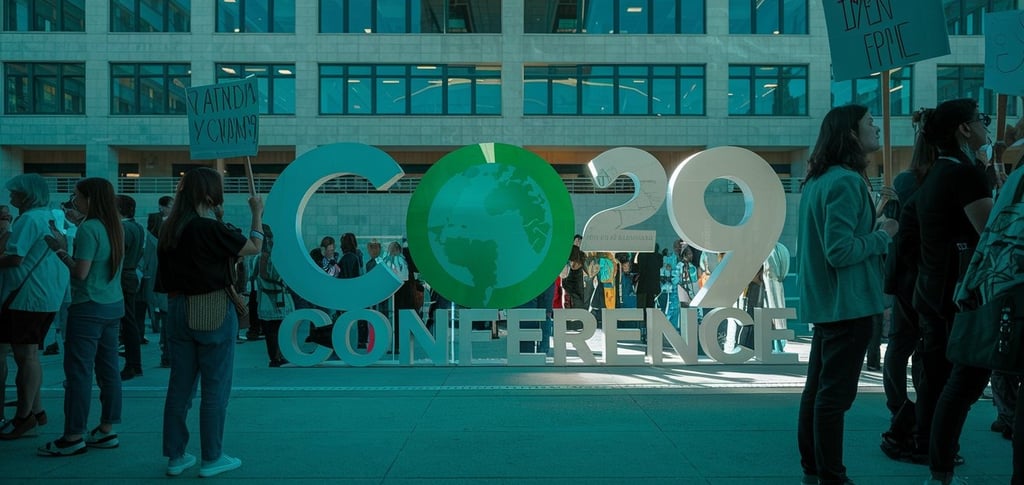COP-29: A Climate of Broken Promises; Billion-Dollar Band-Aids to trillion dollars wounds
How the only thing COP-29 lived up to in its name was CO2 and exploring legal avenues
Ahmed Kamal
11/23/20246 min read


Op-Ed
The Global South's Struggle for Climate Justice Amid COP-29 Disappointment
The conclusion of COP-29 brought a disheartening announcement: wealthy developed nations proposed a mere $300 billion in climate financing, primarily in the form of loans, to address the escalating climate crisis. For billions in the Global South, this proposal is not just inadequate but also a potential debt trap, exacerbating their economic vulnerabilities while offering no real solutions to the climate injustices they face. This move underscores the persistent inequities in global climate politics, where the world's poorest regions, with minimal per capita carbon footprints, are forced to bear the brunt of a crisis they did not cause.
The Inequity of Resource Consumption
If the Global South were to consume resources at the rate of the average American, the world would need 5x more Earths to sustain the demand. This glaring disparity highlights the unsustainable consumption patterns of developed nations, whose industrial and corporate activities have historically driven greenhouse gas (GHG) emissions and environmental degradation. Meanwhile, communities in the Global South—already grappling with the devastating impacts of climate change, such as rising sea levels, extreme weather, and biodiversity loss—continue to suffer from the consequences of actions taken far beyond their borders.
The Case for Reparations
This imbalance has reignited calls for climate reparations. The idea is simple: those who have contributed most to the problem should be held accountable for the harm caused. Reparations could take the form of financial compensation, technology transfers, or infrastructure investments in affected nations. However, achieving this requires a robust legal and political strategy, especially given the reluctance of major polluters to acknowledge their historical responsibility.
Legal Avenues for the Global South
Countries and climate allies must now turn to international and domestic courts to demand accountability and reparations. Several key legal principles and precedents can support such efforts:
International Legal Precedents
Advisory Opinion on Environmental Obligations (ICJ, Pending)
Spearheaded by Vanuatu, this pending case seeks to clarify states' responsibilities under international law concerning climate change. A favorable outcome could establish a legal basis for holding states accountable for climate damages.
Trail Smelter Arbitration (1941)
This landmark case established the principle of transboundary harm, holding states liable for activities within their jurisdiction that cause harm to others. It can be invoked to argue that developed nations' emissions have caused significant harm to vulnerable countries.
Gabčíkovo-Nagymaros Project Case (Hungary/Slovakia 1997)
Highlighting the balance between economic development and environmental protection, this case underscored the enforceability of environmental obligations under international law.
Nuclear Tests Case (Australia/New Zealand v. France, 1974)
Principle: Recognized the importance of environmental harm and the need to avoid actions with significant international environmental consequences.
Relevance: Established the duty of states to prevent harm to the global commons.
Domestic and Regional Case Laws from different Jurisdictions
Juliana v. United States (2015, Ongoing)
In this case, young plaintiffs assert a constitutional right to a stable climate, arguing that government inaction on climate change violates their rights. This framework could inspire similar cases in other jurisdictions.
Urgenda Foundation v. The Netherlands (2015)
A Dutch court ruled that the government must meet its carbon reduction targets, citing human rights obligations. This case demonstrates the power of using rights-based arguments to compel stronger climate action.
Leghari v. Pakistan (2015)
A Pakistani farmer successfully sued his government for failing to implement climate policies, citing constitutional rights to life and dignity. This case highlights how courts can hold governments accountable for inadequate climate policies.
China's courts are newer to climate litigation, but now do have laws and cases like
Environmental Public Interest Litigation (EPIL)
Principle: Chinese courts allow EPIL cases to challenge environmental harm. The Qinghai Lake EPIL case (2015) is an example where plaintiffs succeeded in protecting ecological resources and the Chinese Environmental Protection Law (2014, Revised) which Allows NGOs to sue polluters in public interest cases.
Oposa v. Factoran (1993), decided by the Supreme Court of the Philippines
A group of minors, represented by their parents, filed a petition against the Philippine government. The petitioners argued that deforestation posed an existential threat to their right to a healthy environment and the rights of future generations.
Legal Principle Established
The Philippine Supreme Court recognized the doctrine of intergenerational responsibility:
The present generation holds the environment in trust for future generations.
The government has a duty to ensure the sustainable use and preservation of natural resources.
The court also upheld the right to a balanced and healthful ecology as a fundamental right under the Philippine Constitution.
The Supreme Court ruled in favor of the petitioners, stating that the government must take responsibility for protecting the environment for both current and future generations.
The principle of intergenerational responsibility provides a legal basis for holding governments and corporations accountable for actions that harm the environment and climate.
This principle can support cases where plaintiffs argue that today's inadequate climate policies threaten the rights of future generations. Oposa v. Factoran has inspired environmental litigation worldwide, including climate lawsuits invoking the rights of children and future generations.
Applicability to Climate Reparations:
Intergenerational responsibility strengthens the moral and legal argument that developed nations must address their historical emissions to prevent further harm to vulnerable populations and future generations. The principle aligns with international doctrines like the Precautionary Principle and Sustainable Development, reinforcing its applicability in transboundary and global contexts.
Rylands v. Fletcher (1868)
The principle of strict liability established in this case is particularly relevant. Activities contributing to significant GHG emissions can be likened to the "escape" of hazardous substances, making emitters liable for the resulting harm.
Principle established in this case: A person who, for their own purposes, brings something onto their land that is likely to cause harm if it escapes, is strictly liable for any damage that results from its escape.
Key Features:
The activity must be non-natural use of land.
The damage must be foreseeable if the hazardous substance escapes.
Application in Climate Change Context
Transboundary Harm
Argument: The principle of strict liability could be applied to countries or corporations responsible for significant greenhouse gas (GHG) emissions. GHGs, once released, can be considered an "escape" of hazardous material causing harm globally, especially to vulnerable regions.
Example: Developed nations or large corporations with historically high emissions could be held liable for the transboundary damage caused to countries in the Global South.
Non-Natural Use of Land
Argument: Industrial activities contributing to GHG emissions—such as fossil fuel extraction, deforestation, and large-scale agriculture—qualify as non-natural uses of land. The resulting environmental degradation and climate change impacts could invoke the Rylands v. Fletcher principle.
Corporate Liability
Companies involved in activities with significant climate risks (e.g., oil and gas companies) can be viewed as storing or producing hazardous substances. When these emissions "escape" and cause harm, the principle of strict liability can be invoked, as seen in cases like Milieudefensie v. Shell (2021).
Complementary Doctrines that strengthen the argument based on Rylands v. Fletcher, can be integrated:
The Polluter Pays Principle: Reinforces the notion that emitters must bear the costs of the damage their activities cause.
Public Nuisance: Often paired with Rylands v. Fletcher to address harm to collective resources, such as the atmosphere.
Negligence: If harm can be shown to arise from a failure to mitigate foreseeable risks.
There are also other case laws from different jurisdictions that present similar precedents incorporating similar principles
Bhopal Gas Tragedy (India, 1984): The principle of strict liability was extended to absolute liability for inherently dangerous industries in Indian law.
Lliuya v. RWE AG (Germany, ongoing): A Peruvian farmer is suing a German utility company under the principle of partial causation for climate-related harm, aligning with the Rylands principle of holding entities liable for escape of hazardous elements.
Massachusetts v. EPA (2007): Though a statutory interpretation case, it aligns with Rylands in holding entities responsible for harm caused by their actions or emissions.
Litigation Against Corporations
Cases like Milieudefensie v. Shell (2021), which held Royal Dutch Shell accountable for its emissions, demonstrate that corporations can also be compelled to align their operations with global climate goals.
Potential Challenges
Causation: Establishing a direct causal link between specific emissions and particular climate impacts is often difficult.
Global Nature of Climate Change: Unlike localized escapes, climate harm involves cumulative contributions, which complicates liability under strict liability principles.
Other Legal Principles and International Treaties
Polluter Pays Principle (Stockholm Declaration, 1972): Suggests that those responsible for pollution should bear the costs of managing it.
Precautionary Principle (Rio Declaration, 1992): Justifies preventative action in the face of environmental harm.
Common but Differentiated Responsibilities (CBDR): A principle enshrined in the Paris Agreement, it highlights the historical responsibility of developed nations.
Key Treaties
Paris Agreement (2015): Legally binding treaty with commitments to limit global temperature rise.
United Nations Framework Convention on Climate Change (UNFCCC): Recognizes the global responsibility to address climate change.
International Covenant on Civil and Political Rights (ICCPR): Rights-based approaches to climate accountability.
Conclusion
While pursuing legal action offers hope, it also does presents challenges like Proving a direct link between specific emissions and particular climate impacts can be complex and the principle of Collective Responsibility as Climate change is a cumulative problem, complicating efforts to attribute liability to specific actors.
Nonetheless, courts have increasingly recognized the urgency of addressing climate harms, and a growing body of case law provides a foundation for future litigation. The $250 billion proposal by developed nations at COP-29 is a stark reminder of the systemic inequities in global climate governance. However, the Global South need not accept this outcome passively. By leveraging international and domestic legal mechanisms, affected nations can demand accountability and reparations, ensuring that those who caused the crisis bear the costs of addressing it. This fight for justice is not just about financial compensation—it is about securing a sustainable and equitable future for all.
